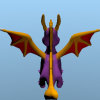- AI (movable areas, path finding)
a generalized engine would generate a nav mesh or A* map once the user designed the game map(s). it would then use built-in AI to make all entities automatically use the nav mesh / A* map,and use A* when moving, or offer this functionality as an option. There's little or no path finding in an F-22 flight sim.
- actions (user defined functionality for character entities, for instance)
this is where you create your own scripting language, and compiler, and an emulator built-in to the generalized engine. this allows the user to program custom behavior into the engine.
- levels (geometry, entity placements)
a generalized engine can't be locked into a single design paradigm such as level based design. the project I'm working on now is a 2500x2500 mile VR paleolithic world for a caveman rpg, and it doesn't have levels, or cells, or any of that "wolf3d is the only way to build a game" stuff. its more like a flight simulator. there's a huge world map, but not a huge world mesh. sections of the "world mesh" are drawn as needed. no loading levels. you can walk all the way from one end of the world to the other.
a generalized engine would need to be able to simulate controlling any type of vehicle, not just a person. so it would need to be able to do flight simulators, sub sims, racing car sims, space fighter sims, snowmobile sims, dragon sims (you're a dragon), etc, etc. this means being able to draw any type of environment, not just a doom level.
from my own work in this area, it seems that a library vs engine may be a more flexible approach. instead of building an engine, you build all the components for every type of game. so you have libraries for drawing ground and sky, and space and planets, water, etc. and you have some libraries for movement and collision detection, and some for path finding and AI, and so on. and all the low level tools like multi-mesh models, an animation system, timers, audio playback, etc.
the thing to do is make a list of all the different types of games you can think of, and what components they require. that's the feature list for your "engine". then you try to generalize the components as much as possible, without making them overly complex to use. in general, the whole point is to make things easier to use, so you have to design such an engine from the API point of view.
I actually did this once. it did a lot of stuff. lost the source code. it was good enough the non-coder artist on the team could build a game with it. now i use the libraries and boilerplate code approach.
- menus (linking to other menus, etc.)
menu text can be stored in data files. what menu picks trigger which sub-menus can also be stored. in the end, they must call some functionality provided by the engine (such as save game), or invoke code written by the user to provide custom functionality.
![]()
![]()
![]() Anyway,
Anyway, ![]() I kept on going.
I kept on going. ![]() Eventually, I was able to store simple data, like game name, window properties, amount of entities, images, 3D models and such. No worries this far!
Eventually, I was able to store simple data, like game name, window properties, amount of entities, images, 3D models and such. No worries this far! ![]()
![]()
![]()






